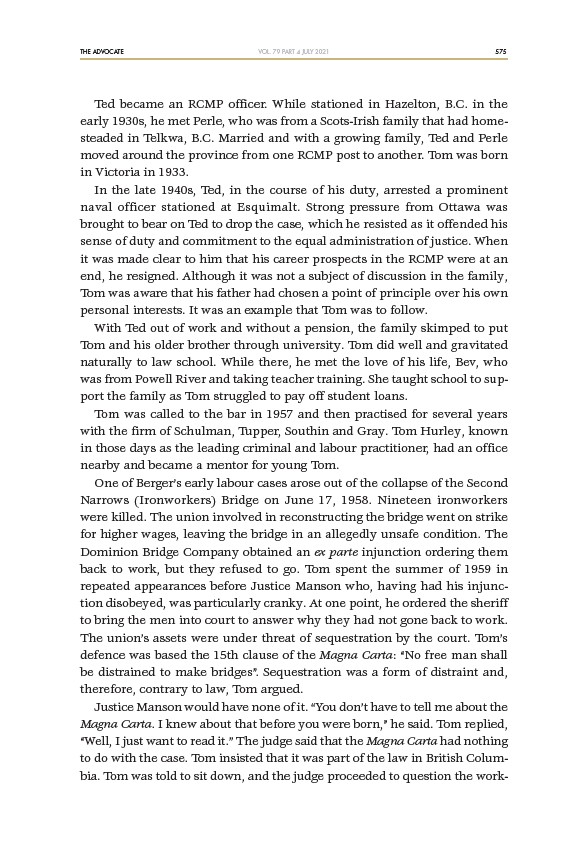
THE ADVOCATE 575
VOL. 79 PART 4 JULY 2021
Ted became an RCMP officer. While stationed in Hazelton, B.C. in the
early 1930s, he met Perle, who was from a Scots-Irish family that had homesteaded
in Telkwa, B.C. Married and with a growing family, Ted and Perle
moved around the province from one RCMP post to another. Tom was born
in Victoria in 1933.
In the late 1940s, Ted, in the course of his duty, arrested a prominent
naval officer stationed at Esquimalt. Strong pressure from Ottawa was
brought to bear on Ted to drop the case, which he resisted as it offended his
sense of duty and commitment to the equal administration of justice. When
it was made clear to him that his career prospects in the RCMP were at an
end, he resigned. Although it was not a subject of discussion in the family,
Tom was aware that his father had chosen a point of principle over his own
personal interests. It was an example that Tom was to follow.
With Ted out of work and without a pension, the family skimped to put
Tom and his older brother through university. Tom did well and gravitated
naturally to law school. While there, he met the love of his life, Bev, who
was from Powell River and taking teacher training. She taught school to support
the family as Tom struggled to pay off student loans.
Tom was called to the bar in 1957 and then practised for several years
with the firm of Schulman, Tupper, Southin and Gray. Tom Hurley, known
in those days as the leading criminal and labour practitioner, had an office
nearby and became a mentor for young Tom.
One of Berger’s early labour cases arose out of the collapse of the Second
Narrows (Ironworkers) Bridge on June 17, 1958. Nineteen ironworkers
were killed. The union involved in reconstructing the bridge went on strike
for higher wages, leaving the bridge in an allegedly unsafe condition. The
Dominion Bridge Company obtained an ex parte injunction ordering them
back to work, but they refused to go. Tom spent the summer of 1959 in
repeated appearances before Justice Manson who, having had his injunction
disobeyed, was particularly cranky. At one point, he ordered the sheriff
to bring the men into court to answer why they had not gone back to work.
The union’s assets were under threat of sequestration by the court. Tom’s
defence was based the 15th clause of the Magna Carta: “No free man shall
be distrained to make bridges”. Sequestration was a form of distraint and,
therefore, contrary to law, Tom argued.
Justice Manson would have none of it. “You don’t have to tell me about the
Magna Carta. I knew about that before you were born,” he said. Tom replied,
“Well, I just want to read it.” The judge said that the Magna Carta had nothing
to do with the case. Tom insisted that it was part of the law in British Columbia.
Tom was told to sit down, and the judge proceeded to question the work-